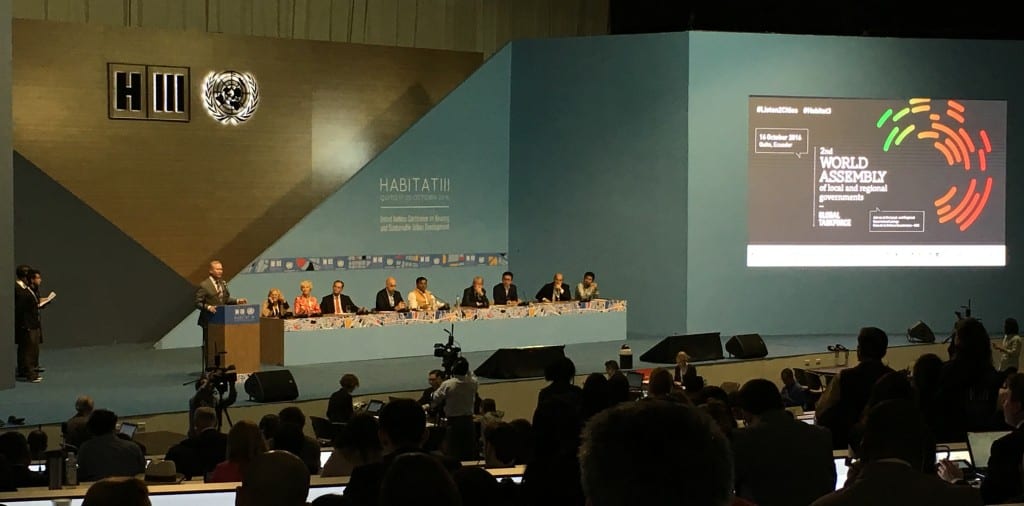Last week, a group of over 45,000 attendees and representatives from 143 countries and 500 cities[1] participated in the adoption of the New Urban Agenda (the Agenda) at the UN-Habitat III conference in Quito. The Agenda includes a vision of sustainable urbanism, common principles held by supporters, and ambitious commitments to make sustainable urban development accessible to all. The conference was organized around three groups of venues: the Main Venue; the Exposition Center; and the Habitat 3 Village.
This blog post presents the major themes we followed at the conference and key outstanding questions.
Who will collect the data for monitoring SDG 11 and the New Urban Agenda?
Currently, no monitoring plan is associated with the Agenda, though it is assumed that a monitoring framework would be an extension of Sustainable Development Goal 11 – the urban goal. While the Agenda makes brief mention of monitoring only in passing – several sessions at Habitat III regarding the monitoring of the Agenda addressed this deficit and opened for discussion alternative methods and guiding principles for monitoring progress.
The Cities Prosperity Initiative (CPI), which has been implemented by UN-Habitat in collaboration with local governments in over 300 cities worldwide, is positioned to evolve into such a framework. Through this initiative, UN-Habitat has developed a holistic index of urban prosperity in cities that utilize local support for data collection and contextual relevance for cities globally. Implementations of the CPI were featured in several presentations displaying significant differences; for example, the Future Saudi Cities Program presented an evaluation scheme based on the CPI with a very strong top-down approach in which the data collection was executed by the national government using local observatories in different Saudi cities. During another presentation, UN-Habitat representatives showcased a new project to decentralize data collection responsibilities.
Will data transparency improve?
One proposed element of the monitoring the New Urban Agenda is the expansion of open data platforms for national and local governments. Several conference sessions and exhibitions highlighted new frameworks and initiatives to collect, analyze and present information at a hyper-local level. Some examples included the application of crowd-sourced data to report anomalies in the city services of Seberang Perai, Malaysia, as well as efforts by the City of Paris and Medellín to be more transparent with urban data. Open government data initiatives offer new opportunities to establish benchmarks through comparison.
Other initiatives featured at the conference include efforts by the private sector and academics to collect and share data through knowledge-sharing platforms including the Global Knowledge Sharing Platform for Sustainable Cities, the Urban Expansion Initiative, the City Resilience Index, and the Global Human Settlements Layer project. The new data made available through these initiatives, along with transparent methods, represent an opportunity to monitor progress toward SDG 11 and the New Urban Agenda. However, as Data Driven researchers, Ryan Thomas and Diego Manya, presented at a Side Event, many environmental performance and sustainability indicators still do not adequately reflect social equity.

Data Driven researcher, Diego Manya, addresses a question from a participant at the UN-Habitat 3 Village.
How will the New Urban Agenda be Implemented?
Implementation of the New Urban Agenda will be planned at the local level. The International Guidelines on Urban and Territorial Planning – a new set of guidelines for urban planning practices – aim to strengthen the role of local governments in the implementation of the New Urban Agenda, as well as ensure that best practices are used to plan at scales from supranational to the neighborhood. Increased attention to secondary cities will play an important role in the implementation of the New Urban Agenda since the majority of urban dwellers live in secondary cities while the majority of planners work in capital cities and megacities.
UN-Habitat is accepting commitments, collectively referred to as the Quito Implementation Plan, from national and sub-national governments, civil society, NGOs, and private businesses toward the implementation of the Agenda. Commitments to facilitate implementation range from NGOs hawking innovative solutions to the lack of toilets in developing countries to the European Commission’s statement of commitment to implement the New Urban Agenda.

The 2nd World Assembly of Local and Regional Governments addressed the plenary session calling for greater recognition of sub-national governments within the UN.
Where do cities stand on the global stage?
Finally, an important paradox was mentioned in the midst of the adoption of the New Urban Agenda, as CityLab noted, the New Urban Agenda was approved by nations and not cities. The 2nd World Assembly of Local and Regional Governments, a group representing over 500 mayors,met in the days leading up to the conference and presented their position moments after the New Urban Agenda was approved by the representatives of the national governments. The mayor of Quito, Mauricio Rodas, remarked what many local and regional governments around the world feel – that in order to fully realized the goals of the New Urban Agenda, cities need to be given a more direct way to access international resources and greater importance to make interventions and decisions in the UN system.
Footnotes
1. According to UN-Habitat Executive Director Joan Clos in his closing remarks.

Recent Comments